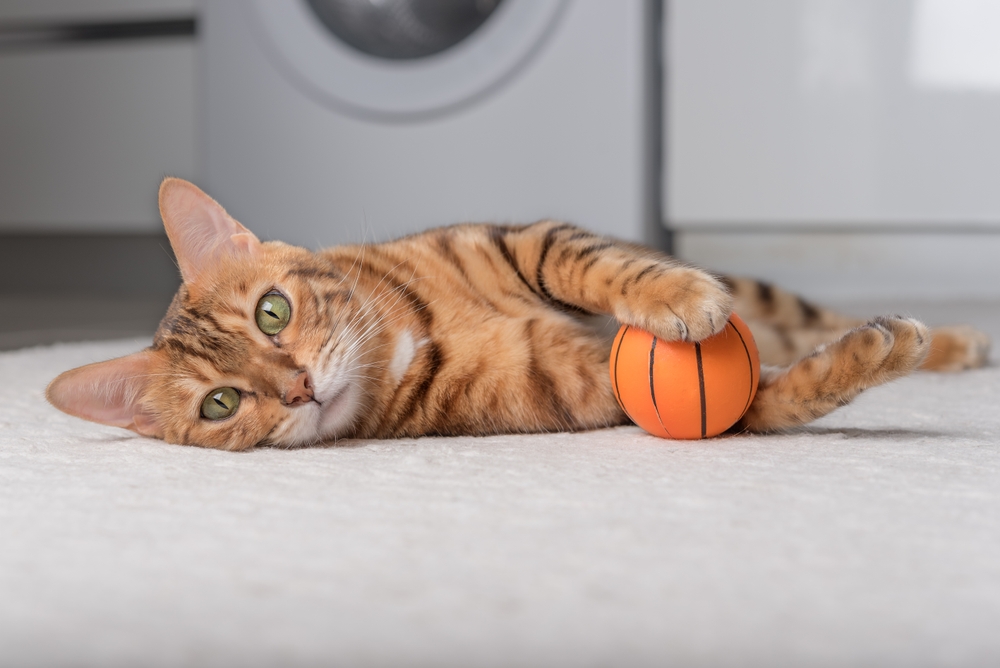Your Adult Cat: What to Expect at 5 – 6 Years
Updated on October 08, 2024

When your cat reaches 5 to 6 years old, he is nearing middle age. While not yet considered a senior cat, he is at the age when you need to begin watching for age-related changes. Here is what you need to know to keep your cat healthy as he gets older.
All featured products are chosen at the discretion of the Vetstreet editorial team and do not reflect a direct endorsement by the author. However, Vetstreet may make a small affiliate commission if you click through and make a purchase.
Physical and Mental Development
No one knows your cat better than you do. By observing your cat closely and giving him a good going-over once a week, you are more likely to catch changes or abnormalities early. A good time to check your cat is when you’re grooming him, which should also be done at least weekly. First, run your hands along your cat’s body to feel if he is gaining or losing weight. Weight change could be a sign of illness or the need for a veterinarian-supervised diet change. Watch for lumps and bumps too. If you feel a lump, ask your veterinarian to look at it promptly.
Here are some additional areas to check:
- The eyes should be clear and bright, without redness or tearing.
- The nose is usually cool to the touch and moist.
- The ears should be clean and have minimal wax. Any foul odor or debris may indicate an infection or ear mites.
- The teeth should be clean and white (even in the back), and the breath should not smell foul. Unpleasant mouth odor can be coming from an unhealthy mouth (caused by dental disease) or could indicate an illness such as gastritis, cancer, kidney problems or diabetes.
- The gums should be a healthy pink.
- The footpads should be free from cuts or foreign objects, and the toenails should not be red or broken.
- The skin should look healthy, and the fur should be clean and shiny. Look for sores, bald patches, or redness to the skin. Dark grains through the fur that turn red when wet could be signs of a flea infestation. A dry coat falling out in patches can indicate a medical problem.
- The cat’s tail should be healthy looking, not hanging limp. Be sure to examine it to see if your cat has been chewing on it, and check underneath to be sure the rump is clean of fecal material.
You should also watch your cat for changes in drinking or urination, fecal or urinary accidents around the house, vomiting, changes in appetite, or changes in activity level. You should discuss any unusual findings or changes with your veterinarian to determine whether further investigation is needed.
Behavior Changes
House soiling is the most common behavioral problem in adult cats. At this stage, your cat will have learned to use the litterbox long ago. If your cat is having accidents, you should first determine if your cat is urinating or marking. When cats mark, they remain standing, backing up to their target surface.
Marking is far more common in male cats that have not been neutered. If the cat is squatting, he is urinating. Urinary accidents can indicate that your cat may have a medical problem, in which case you need to take him to the veterinarian for further evaluation and treatment, as some problems can be very serious.
Other behavioral problems can include aggression and scratching. By providing your cat with regular meal times, the space and privacy he needs, and an appropriate place to scratch, these problems can generally be managed or corrected.
Health & Nutrition
Although a 6-year-old cat is not considered “old,” your veterinarian may decide to run standard lab tests periodically as a precaution, hoping to catch any problems early. Additionally, you should be discussing regular dental care with your veterinarian.
Watch your cat’s weight, too. The typical house cat should weigh about 8 to 12 pounds — although some breeds (like the Maine Coon) can weigh much more. Obesity contributes to a number of health problems, including diabetes, heart disease, respiratory stress and joint problems. If you have a fat cat, try following these suggestions:
- Switch from “free feeding” (open buffet style) to scheduled feedings.
- Ask your veterinarian if a lower-calorie cat food is a good idea, or at least discuss how much you might want to cut back on your cat’s current food intake.
- Play with him more often to help ensure he gets adequate exercise.
- Cut down the number of treats you offer him between meals. Remember, kitty treats count toward his caloric intake too.
Pet Health Insurance Can Help
Unexpected veterinary bills can make caring for your pet challenging. Don’t let financial stress get in the way of making the best decisions for your pet. Pet health insurance can cover surprise costs such as veterinary visits, prescription medications, and life-saving procedures.
Review personalized options for your pet below:
Training Tips
Playing games with your cat engages him mentally and physically; simple toys will keep him engaged and active. A track ball toy is designed to let your kitty entertain himself. These toys have a ball that rolls around inside a closed circular track. Openings allow the cat to insert a paw and pat the ball.
You can also make your own toys. Wash out an empty plastic gallon milk jug and cut a few circular openings in the jug, big enough for your cat’s paw (but too small for his head) to fit through. File down any sharp edges, or duct-tape around the openings to make sure sharp edges are covered. Then drop a ping-pong ball or catnip toy in the jug. To start the play, show your cat the toy and move it around. Your job will be to put the toy back in the jug each time he fishes it out.
Enjoying creative playtime with your adult cat is just as important as it was when he was a kitten. Keeping your cat healthy and happy requires some patience and diligence, but it can be a whole lot of fun.



